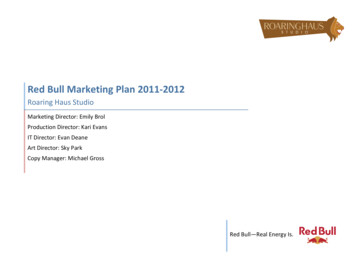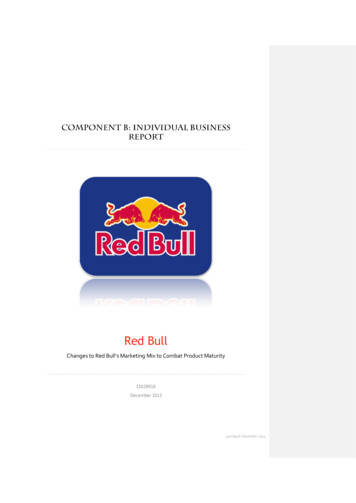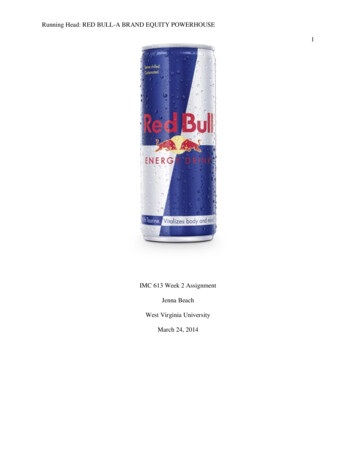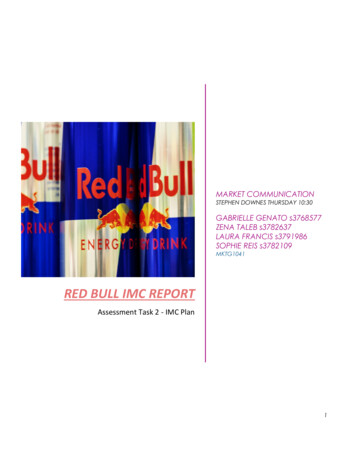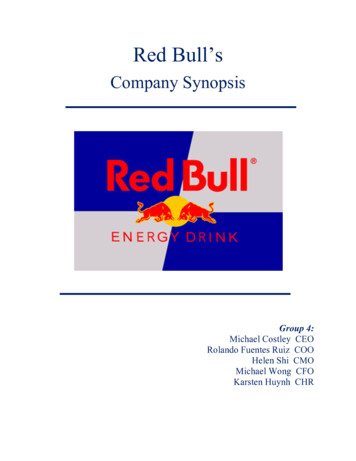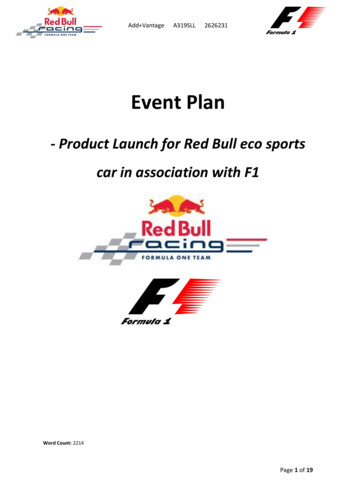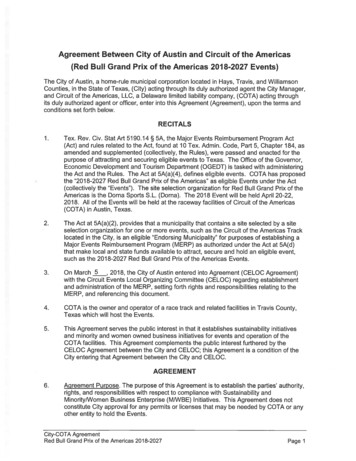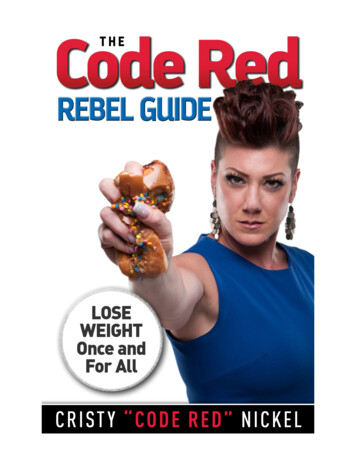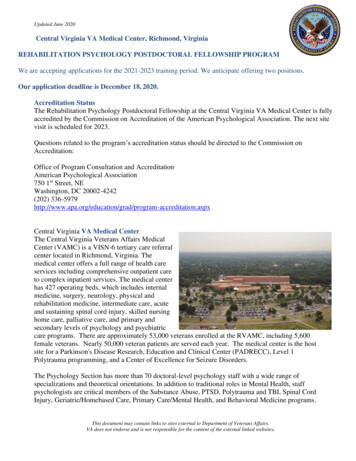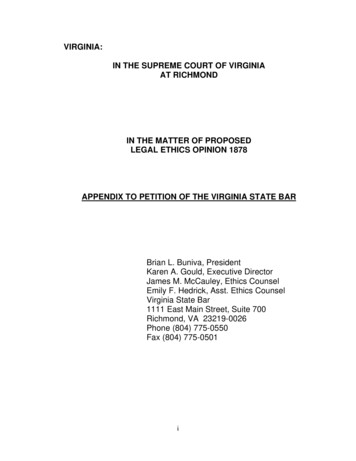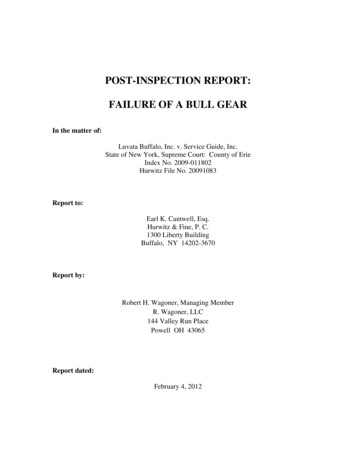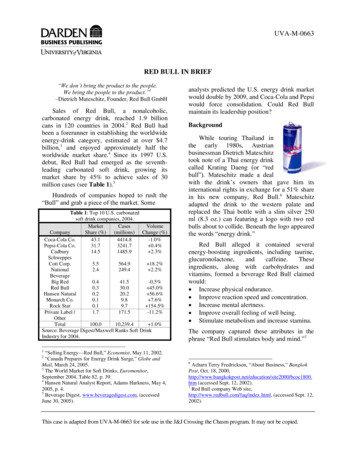
Transcription
UVA-M-0663RED BULL IN BRIEF“We don’t bring the product to the people.We bring the people to the product.”1–Dietrich Mateschitz, Founder, Red Bull GmbHSales of Red Bull, a nonalcoholic,carbonated energy drink, reached 1.9 billioncans in 120 countries in 2004.2 Red Bull hadbeen a forerunner in establishing the worldwideenergy-drink category, estimated at over 4.7billion,3 and enjoyed approximately half theworldwide market share.4 Since its 1997 U.S.debut, Red Bull had emerged as the seventhleading carbonated soft drink, growing itsmarket share by 45% to achieve sales of 30million cases (see Table 1).5Hundreds of companies hoped to rush the“Bull” and grab a piece of the market. SomeTable 1: Top 10 U.S. carbonatedsoft drink companies, 2004.MarketCasesVolumeCompanyShare (%)(millions) Change (%)Coca-Cola Co.43.14414.8-1.0%Pepsi-Cola Co.31.73241.7 0.4%Cadbury14.51485.9 2.3%SchweppesCott Corp.5.5564.9 18.2%National2.4249.4 2.2%BeverageBig Red0.441.5-0.5%Red Bull0.330.0 45.0%Hansen Natural0.220.2 56.6%Monarch Co.0.19.8 7.6%Rock Star0.19.7 154.5%Private Label /1.7171.5-11.2%OtherTotal100.010,239.4 1.0%Source: Beverage Digest/Maxwell Ranks Soft DrinkIndustry for 2004.analysts predicted the U.S. energy drink marketwould double by 2009, and Coca-Cola and Pepsiwould force consolidation. Could Red Bullmaintain its leadership position?BackgroundWhile touring Thailand inthe early 1980s, Austrianbusinessman Dietrich Mateschitztook note of a Thai energy drinkcalled Krating Daeng (or “redbull”). Mateschitz made a dealwith the drink’s owners that gave him itsinternational rights in exchange for a 51% sharein his new company, Red Bull.6 Mateschitzadapted the drink to the western palate andreplaced the Thai bottle with a slim silver 250ml (8.3 oz.) can featuring a logo with two redbulls about to collide. Beneath the logo appearedthe words “energy drink.”Red Bull alleged it contained severalenergy-boosting ingredients, including nts, along with carbohydrates andvitamins, formed a beverage Red Bull claimedwould: Increase physical endurance. Improve reaction speed and concentration. Increase mental alertness. Improve overall feeling of well being. Stimulate metabolism and increase stamina.The company captured these attributes in thephrase “Red Bull stimulates body and mind.”71“Selling Energy—Red Bull,” Economist, May 11, 2002.“Canada Prepares for Energy Drink Surge,” Globe andMail, March 24, 2005.3The World Market for Soft Drinks, Euromonitor,September 2004, Table 82, p. 39.4Hansen Natural Analyst Report, Adams Harkness, May 4,2005, p. 4.5Beverage Digest, www.beveragedigest.com, (accessedJune 30, 2005).26Acharn Terry Fredrickson, “About Business,” BangkokPost, Oct. 18, /bcoc1800.htm (accessed Sept. 12, 2002).7Red Bull company Web site,http://www.redbull.com/faq/index.html, (accessed Sept. 12,2002).This case is adapted from UVA-M-0663 for sole use in the J&J Crossing the Chasm program. It may not be copied.
UVA-M-0663-2Successful Introduction in AustriaMateschitz’s native Austria restricts claimsregarding performance benefits under its lawsfor “traditional foods.” Arguing its productcontained characteristics of all three of Austria’sfood and drug categories—traditional, dietary,and pharmaceutical—Red Bull successfullylobbied the government to create a newclassification, “functional foods.” The categoryrequired extensive documentation to supporthealth-benefit claims, which created an entrybarrier that slowed competitors.8Red Bull debuted in Austria in 1987. Thecompany said the product was suitable “when along day is over and a long night starts Onlong, sleep-inducing motorways Duringintensive working days Prior to athleticactivities or in a performance drop Beforetests and exams As first-aid after a long partynight.”9 Red Bull provided tips for the best useof its product during athletic events lasting morethan an hour: “drink 1-2 cans about 30-45minutes before the end of the competition.”10Early adopters of Red Bull included peopleattending clubs and rave parties. NorbertKraihamer, the company’s global director ofmarketing and sales, explained:There are five user categories: students,drivers, clubbers, business people andsports people I find loyal customers assoon as I can convince them the productworks. If the product keeps themawake, in a good mood, focused,vigilant, then they’ll buy again If youdo it right, you’ll be getting up to 75%or even 80% re-purchase rate. 11In nightspots, Red Bull was often used as amixer. Kraihamer said the company was notopposed to this, but that “we must make sure8Kevin Lane Keller, “Red Bull: Branding Brand Equity inNew Ways,” Strategic Brand Management and BestPractice in Branding Cases, 2nd Ed., (Prentice Hall: 2003),p. 53–72.9Red Bull company Web dex.html,(accessed Sept. 17, 2002).10Claire Phoenix, “Red Bull—Fact and Function,”Softdrinksworld, Feb. 2001, p. 26–35.11Phoenix.A Red Bull Flügtag participant prepares to launch.that the product is regarded as much more than amixer. This is a nutritional item.”12The company charged up to four times moreper ounce than average soft drink producers( 1.99- 3.00 per 250 ml can) and deliberatelyset prices at least 10% above competing energydrinks to maintain a premium image.Red Bull’s market entry strategy reliedheavily on word-of-mouth and “seeding.” Thecompany targeted a select handful of hip andtrendy clubs, bars, and stores and limitedavailability. After six months of seeding, itintroduced its product around the seedinglocations. The final step was to entersupermarkets, thus reaching the mass market.13Red Bull also targeted specific celebritiesand sponsored sporting events ranging from carracing to extreme skiing to the “Flügtag,” whereparticipants launched homemade flying objectsoff of a ramp into a lake.Unlike any other major beverage company,Red Bull launched traditional advertising last.The approach was to reinforce rather thanintroduce the brand. The company invested 65%of sales in its early days in marketing.14Red Bull began employing the slogan “RedBull Verleiht Flüüügel” (“Red Bull Gives YouWii-ings”) in an “adult cartoon” advertisingcampaign that featured one character with anenergy deficiency and another with a solution:12Phoenix.Keller.14Phoenix.13
UVA-M-0663-3Red Bull. The animated spots transcendedspecific target groups, enabling the company toestablish a wide consumer base. 15Navigating the U.K. MarketIn the 1990s, most countries in the EuropeanUnion (Austria was not yet a member) had a listof allowable food ingredients. Taurine was noton the list. However, Red Bull was able to enterthe United Kingdom (U.K.) through Scotland, asit maintained a list of ingredients not approvedfor use in food, and taurine was not on the list.This enabled access to other European markets16(see Figure 1).Figure 1: Red Bull early market entries.1987 –1992 –1993 –1994 –1995 –AustriaHungaryScotlandGermanySloveniaBaltic StatesCzech U.K.1996 –1997 –1998 –1999 –BelgiumGreeceNew ZealandPortugalRomaniaSpainSwedenIrelandSouth AfricaU.S.A.BrazilFinlandItalyAustraliaSource: Claire Phoenix.The U.K. sports and energy drink marketconsisted of two segments at the time of RedBull’s entry in 1995: refreshment drinks offeringenergy through glucose and isotonic sportsdrinksdesignedtoenhancephysicalperformance and provide replenishment. 17Red Bull changed its traditional marketentry strategy as it launched in the U.K. First, itmarketed Red Bull as a sports drink instead of astimulation drink. Second, the company sold theproduct immediately through mass-marketchannels like chain stores. Third, its traditionalmarketing mix was ignored in favor of abillboard campaign. The company also chose anew slogan: “You should never underestimatewhat Red Bull can do for you.” 18 By the end of1996, Red Bull’s share of the U.K. sports- andenergy-drink market was less than 2%.19The U.K. management team was soonreplaced with a group that repositioned Red Bullas a functional energy (or stimulation) drink,thus creating a third segment in the U.K. market.The team returned to the company’s traditionalmethod of building markets through word-ofmouth and replaced the U.K. slogan with whathad worked in Austria.Red Bull’s U.K. volumes tripled in 1998 andquadrupled in 1999 to sales of 170 million cans.They climbed another 50% in 2000 to 260million cans.20 By 2004, Red Bull had becomethe third-leading soft drink by value in the U.K.,trailing only Coca-Cola and Pepsi. The brandheld a 62% share of the growing “functionalenergy” segment of the sports- and energy-drinkmarket.21 Red Bull achieved significant marketpenetration among 14-19 and 20-29 year olds,with 32% saying they drank it in bars at nightand 13% calling it their favorite drink.Kraihamer credited Red Bull’s premiumprice as part of the brand’s success in the UnitedKingdom.22America: A Bull Market?Red Bull was introduced to the U.S. marketin 1997. The company launched the product in ahandful of targeted geographic areas, or “cells.”As Kraihamer described:Our intention was never to go to theStates and say “We are launching RedBull .” Santa Cruz was the first testmarket. Then we went to parts of SanFrancisco. After that we went to SantaMonica—our home base in the U.S. Ourconcept works better the smaller thecommunity we go into, because we areword-of-mouth people.23Red Bull maintained its strategy ofappearing first in trendy on-premise locations. Italso sponsored several dozen alterna-athletes19Keller.Phoenix.21“The European Market for Energy & Sports Drinks to2006,” http://www.mindbranch.com, (accessed June ��UK Energy and Sports Drinks—Space The FinalFrontier,” Softdrinksworld, Feb. 2001, p. 36–43.18Phoenix.16
UVA-M-0663-4and underwrote extreme sports competitions,such as the Red Bull Huckfest ski andsnowboard competition in Utah. The fourth RedBull Music Academy, held in New York City in2001, drew 60 club deejays from around theworld to learn from master deejays. The deejayswere under no obligation to promote Red Bullwhen they returned to their clubs, but thecompany hoped they would mention it and creditthe company for supporting the scene.24Entering 2005, Red Bull was spending 600million annually on worldwide advertising andmarketing, which represented 30% of sales.25 Incontrast, Coca-Cola spent 9% on advertising(albeit on sales of 20 billion).26 Some industryobservers believed measured media accountedfor only about 18% of Red Bull’s totalmarketing.27 (A Red Bull spokesperson disputedthe figure, saying its events and sponsorshipswere more costly than most realized.28)The Soft and Functional Drinks MarketIn 2003, the global soft-drink market wasestimated at nearly US300 billion andaccounted for approximately 11 trillion U.S.fluid ounces.29 The soft-drink market generallyincluded carbonated soft drinks (40% ofmarket), bottled water (35%), fruit/vegetablejuice (12%), tea (4.5%), coffee (0.9%), Asianspecialty drinks (2.7%), concentrates (0.8%),and functional drinks (3%). Functional drinksencompassed sports drinks, energy drinks, andelixirs (a beverage with curing properties).By 2001, Red Bull had captured 65% of the 275 million energy-drink market it helpedcreate.30 Around that time, Anheuser-Buschlaunched 180, Coke introduced KMX, and Pepsibrought to market Mountain Dew Amp andSoBe Adrenaline Rush. Other entrants includedSnapple Venom, Arizona Extreme Energy, BlueOx, Bomba Energy, Dark Dog, Red Alert,Deezel, Power Horse USA, Go-Go Energy, and24Hein.Phoenix.26Kerry A. Dolan, “The Soda with Buzz,” Forbes, March28, 2005.27Kenneth Hein, “A Bull’s Market.”28Walker.29The World Market for Soft Drinks, Euromonitor,September 2004, Table 80, p. 39.30Walker.25Hemp Soda.31 Still, Red Bull maintained itsposition as the leader of the pack. 32The U.S. energy-drink market was estimatedat 1.6- 2 billion in 2004, with growth between58% and 73%.33 Red Bull’s overall U.S. marketshare dropped from 75% in 1998 to 47% in2005.34 Several competitors had grown theirdistribution and appeal (see Exhibit 1).In 2002, California’sHansen Natural launchedMonster, packaged in blackcans with neon-accented clawmarks. The cans were doublethe volume of Red Bull’s andoffered to distributors for acomparable price ( 1.99 forthe final consumer).35 Hansensupported the launch with itsslogan “Unleash the Beast”and sent out teams tural –skateboarding competitions,Monsteras well as concerts and beachEnergy Drinkparties. Hansen experiencedsales increases of 162% in 2004. This propelledit to second place in the energy drinks segmentwith an 18% market share.Rock Star launched its energy beverage in2001 and occupied third place in the U.S. marketwith a 16% share. Rock Star’s primaryconsumers were teenage males, and thecompany promoted its brand through celebritiesand music events. In 2005, Rock Star contractedwith Coca-Cola for distribution.3631Kenneth Hein, “Necessity and Invention,” Brandweek,Feb. 19, 2001, p. 22.32Sweeney.33Adams Harkness; and Scott Leith, “The Buzz on EnergyDrinks: Coke, Pepsi and Tiny Firms Vie for Sip ofCaffeine-Packed Beverage Market,” Atlanta JournalConstitution, April 8, 2005, p. F1.34Dolan.35Christopher Palmeri, “Hansen Natural; Charging at RedBull with a Brawny Energy Brew,” BusinessWeek, June 6,2005, p. 74.36“Food Brief – Coca-Cola Co. Deal Is Reached toDistribute another Firm’s Energy Drink,” Wall StreetJournal, April 29, 2005, p. A11.
UVA-M-0663-5-Pepsi teamed up with Starbucks launchStarbucks Frappuccino iced coffee andStarbucks DoubleShot espresso drink, whichheld 90% of the noncarbonated, ready-to-drinkcoffee segment as of 2005.42 In other countries,companies (including Red Bull) wereexperimenting with a fusion of coffee, milk, andenergy drinks.43Rock Star Energy Drinks.
Red Bull’s market entry strategy relied heavily on word-of-mouth and “seeding.” The company targeted a select handful of hip and trendy clubs, bars, and stores and limited availability. After six months of seeding, it introduced its product around the seeding locations. The final step was to enter supermarkets, thus reaching the mass market.13 Red Bull also targeted specific celebrities .File Size: 272KBPage Count: 6
